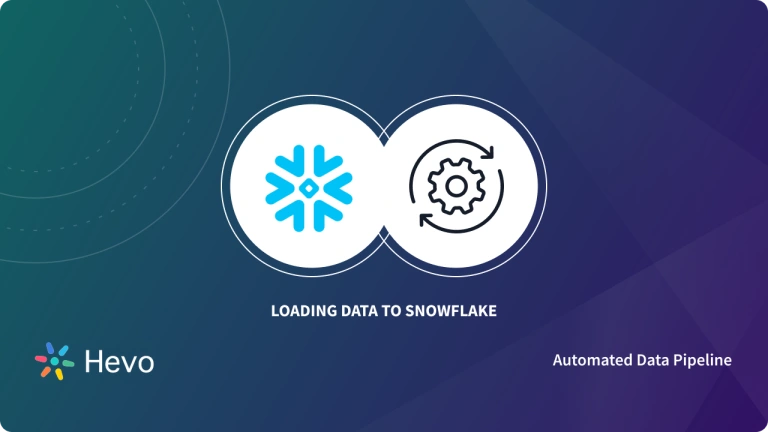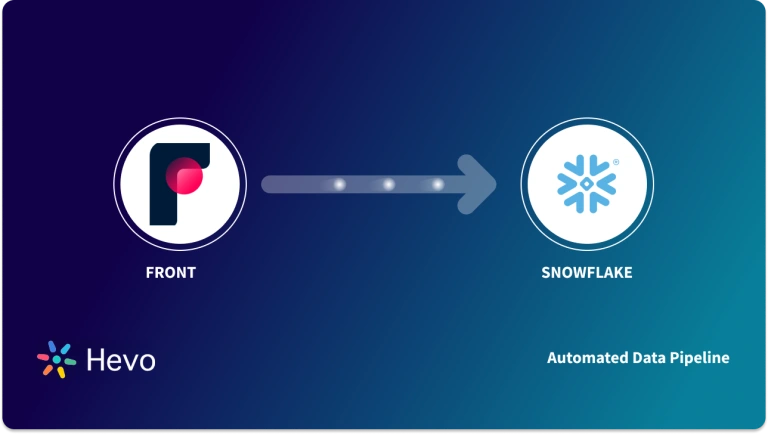The Front provides a platform for organizations to communicate with customers across different channels such as emails, texts, WhatsApp, social media chats, and more. Although Front can keep all the customer information from these channels and help obtain insights, transferring this data to a data warehouse such as Google BigQuery would further help organizations analyze and improve decision-making processes. You can connect Front to BigQuery using standard APIs and third-party ETL (Extract, Load, and Transform) tools.
In this article, you will learn to connect Front to BigQuery using manual processes. Let’s get started!
Table of Contents
What is Front?
Front is a communication hub that helps organizations strengthen customer relationships by providing a platform to deliver exceptional customer experiences. It centralizes customer interactions across multiple channels like emails, texts, social media, calls, and WhatsApp, allowing teams to collaborate and respond in real-time. With powerful analytics, Front offers a complete 360-degree view of customers, giving organizations full control to identify and resolve issues, ultimately enhancing the overall customer experience.
Key Features of Front
- Collaboration: Organizations can access customer data across multiple channels in one place in the team inbox with Front. Front ensures that every member of the team can access every customer message. Therefore, whenever there is a customer query in the team inbox, the team in organizations can quickly inform the intended person to handle the query without delay.
- Automated integrations: The front consists of no-code automation and integration capabilities that replace the complexity of the manual integration processes. It includes an integration library, allowing you to connect Front to your favorite tools, CRM, and chatbots. Such integration is easy to use and can be completed with simple clicks. The front also consists of plugin integration for Salesforce, Shopify, Aircall, and more. As a result, organizations can quickly transfer data for collaboration.
- Win more customers: Since Front enables businesses to collect data from several sources like emails, chats, social media, texts, WhatsApp, and more, businesses can seamlessly resolve customers’ issues and keep them happy.
What is Google BigQuery?
Google BigQuery is a fully managed data warehouse that allows businesses to store and analyze terabytes of data using standard SQL for fast results. It leverages Dremel technology and columnar storage for high performance and data compression. BigQuery helps reduce costs by independently scaling storage and compute power. Developers and data scientists can work with languages like Java, Python, and JavaScript or use BigQuery’s API for efficient data management and transformation.
Key Features of Google BigQuery
- BigQuery BI engine: BigQueryBI consists of the BI engine that helps organizations process large datasets with sub-second query response time and high concurrency. The BI engine can integrate with powerful tools such as Google Data Studio, Tableau, Power BI, and more for data analysis. It can also work with tools such as API libraries, JDBC drivers, BigQuery SQL, and more.
- Machine learning: Google BigQuery allows organizations to create machine learning models with SQL queries. Machine learning models like Logistic Regression, Binary Logistic Regression, Multi-Class Regression, K-means clustering, and more are supported by BigQuery.
- User friendly: Google BigQuery allows organizations to store and analyze their data with just a few clicks. The user-friendly interface of Google BigQuery enables users to set up a cloud data warehouse because they do not need to install clusters, choose storage size, encryption settings, and configure compression.
- Real-time Analytics: BigQuery can keep you up-to-date with real-time transfer and analytics. It can allocate resources intelligently to deliver the best performance and outcomes, allowing you to generate business reports as needed.
How to Connect Front to BigQuery?
Method 1: Establish Front To BigQuery Connect using Hevo Data
Hevo Data provides you a hassle-free solution to connect Front to BigQuery within minutes with an easy-to-use no-code interface. Hevo is fully managed and completely automates the process of not only loading data from Front but also enriching the data and transforming it into an analysis-ready form without having to write a single line of code.
Get Started with Hevo for FreeMethod 2: Manual Method to Move Data from Front to BigQuery
This method would be time-consuming and somewhat tedious to implement. Users will have to manually export Front Data & then Import Data to Google BigQuery. This method is suitable for users with a technical background.
Method 1: Establish Front To BigQuery Connect using Hevo Data
Hevo provides Google BigQuery as a Destination for loading/transferring data from various sources including Front (Free Source).
- Front to BigQuery Step 1: Configuring Front as a Source
- Front to BigQuery Step 2: Configure Google BigQuery as the Destination
Front to BigQuery Step 1: Configuring Front as a Source
To set up Front as the Source in your Pipeline in Front to BigQuery Integration, follow these instructions:
- Step 1: In the Asset Palette, choose PIPELINES.
- Step 2: In the Pipelines List View, click + CREATE.
- Step 3: Choose Front on the Select Source Type page.
- Step 4: Enter the following information on the Configure your Front Source page to connect Front to Redshift:
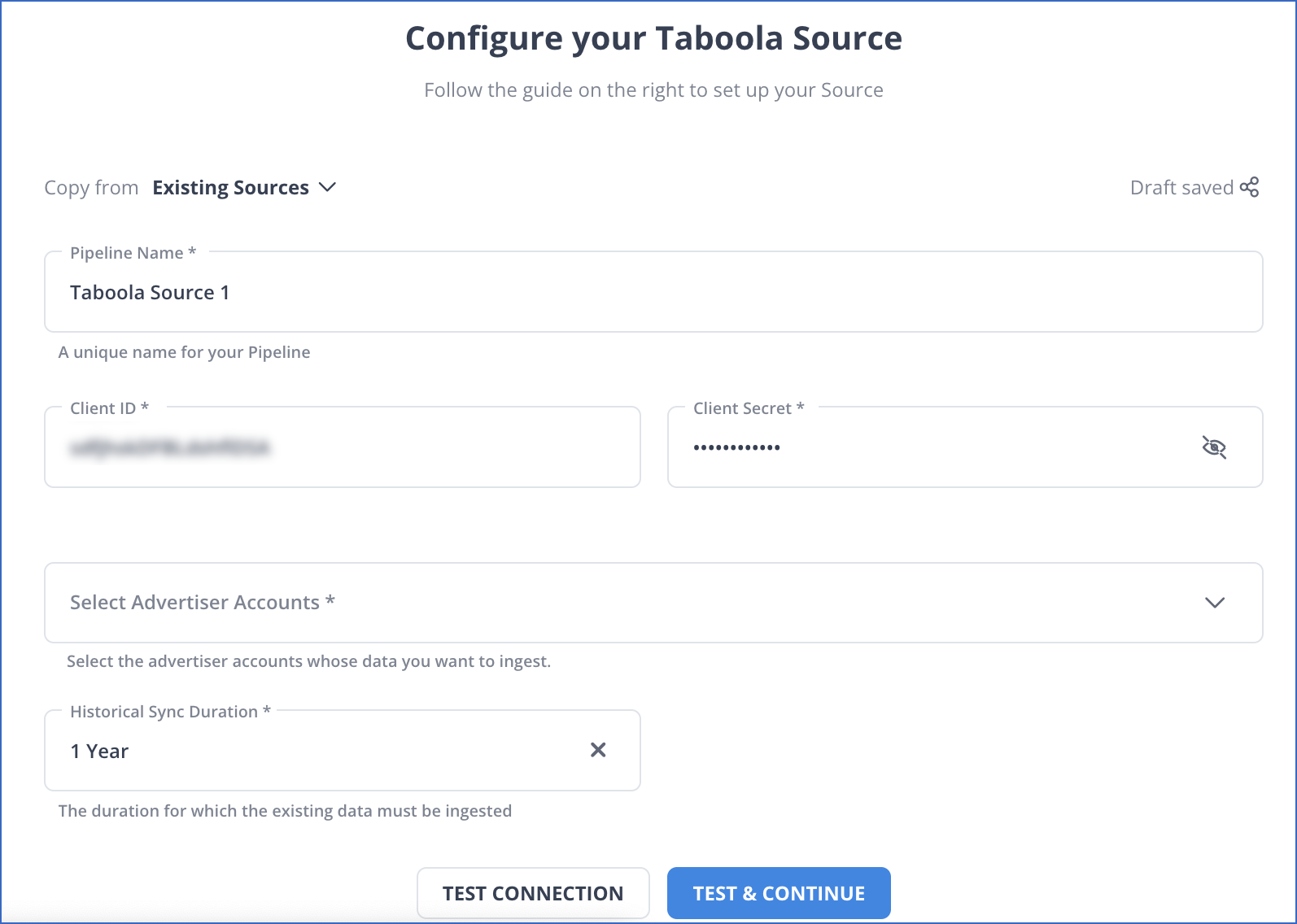
- Step 5: Just hit the TEST & CONTINUE button.
- Step 6: Configure the data ingestion and set up the Destination.
Front to BigQuery Step 2: Configure Google BigQuery as the Destination
- Click DESTINATIONS in the Asset Palette.
- Click + CREATE in the Destinations List View.
- In Add Destination page select Google BigQuery as the Destination type.
- In the Configure your Google BigQuery Account page, select the authentication method for connecting to BigQuery.
| Note: 1. To connect using a Service Account: a. Attach the Service Account Key file. b. Click CONFIGURE GOOGLE BIGQUERY ACCOUNT. 2. To connect using a User Account: Click + ADD GOOGLE BIGQUERY ACCOUNT. a. Sign in as a user with BigQuery Admin and Storage Admin permissions.b. Click Allow to authorize Hevo to access your data. |
Method 2: Manual Method to Move Data from Front to BigQuery
Today, customers use several digital communication platforms like social media, in-app chats, emails, and more. Although Front brings all customer communication data in a single platform, it is limited by the type of analytics you can perform.
Consequently, moving the data to Google BigQuery can allow you to not only leverage the capabilities of BI tools for analytics but also enables machine learning techniques with the customer data for generating insights. Such capabilities can allow organizations to differentiate in the competitive landscape by making better customer-centric decisions.
- Front to BigQuery Step 1: Exporting Front data
- Front to BigQuery Step 2: Importing data to Google BigQuery
Front to BigQuery Step 1: Exporting Front data
To connect Front to BigQuery, you must export Front data and then import it to Google BigQuery.
It is assumed that you have signed in to Front. You can connect your workspace with your Gmail account in Front. After setting your workspace, you can create shared inboxes, collaborate with your teams, add message templates, and create rules with Front.
Front Analytics consists of seven dashboards to analyze your team’s performance and increase efficiency. You can create reports to filter specific channels and teams. Front helps organizations export these reports into the csv files.
Follow the below steps to export Front report data to the csv file.
- Click on the three dots on the top right of the report view. Select the Export view Data.

- Select your type of export in the Export field and then click on the Request export.
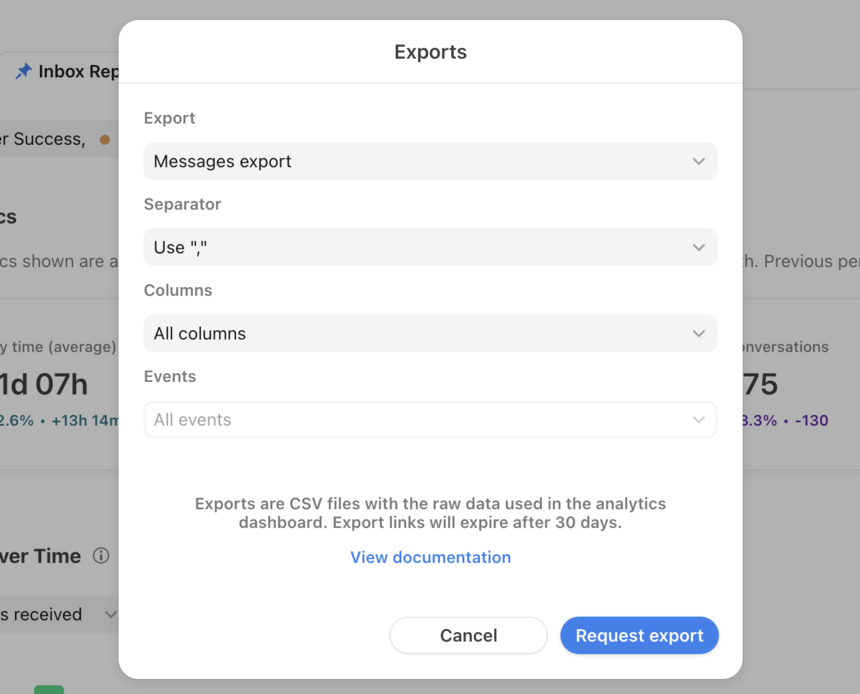
- You can see the prepared exports at the bottom of the pop-up screen, ready to be downloaded. Click on the Download export icon to save the export to your computer.
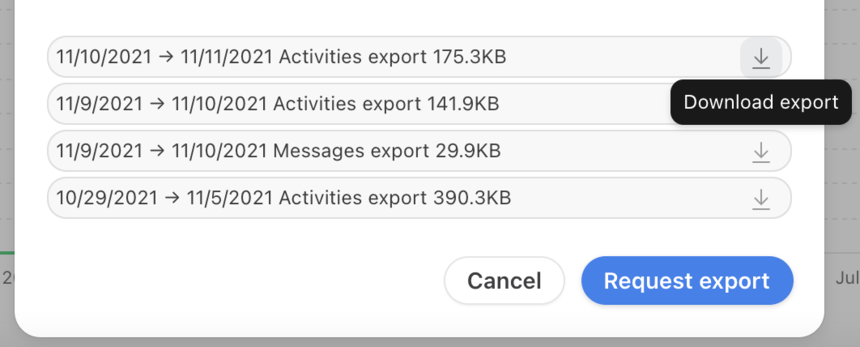
Note: The front also allows you to export metric details to view all the conversations included in the specific metric in your report. Follow the below steps to export metric details:
- You can click on the metric in your report to pull up the metric details.
- At the top list of conversations, click on the Export icon.
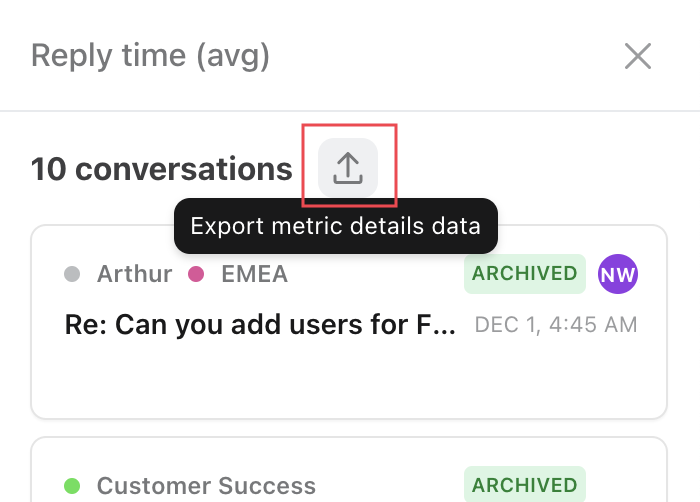
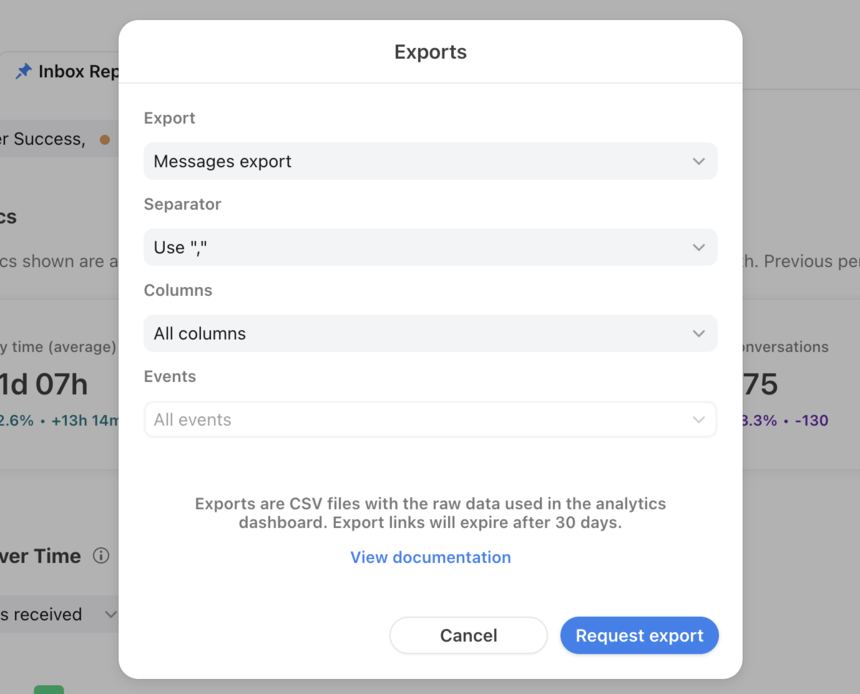
- Select your type of export in the Export Field and click on the Request export.
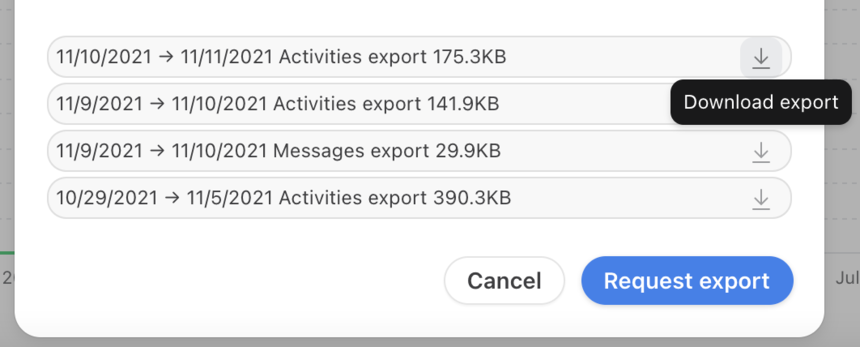
- At the bottom of the pop-screen, you can see the prepared exports. Click on the Download arrow icon to save the export data.

Front lets users export data from individual charts and tables in their reports. The csv file can contain the same pre-calculated metrics you can see in the corresponding chart or table on your dashboard.
- Click on the export icon at the top right of the table to download its data.
Front to BigQuery Step 2: Importing data to Google BigQuery
You can load any data file in Google BigQuery, but in this article, you will learn to import a csv file in Google BigQuery.
When you load the csv file from Cloud Storage, you can load that file into a new table or partition. Google BigQuery also allows you to append your csv file to overwrite an existing table or position. When your csv file is loaded in Google BigQuery, it is converted into the columnar format for Capacitor.
Before loading the csv file into Google BigQuery, you must provide the IAM permissions for loading data into BigQuery and partitions.
- Permissions to load data into BigQuery
You require the below IAM permissions for loading data and appending or overwriting an existing table or partition in BigQuery.
bigquery.tables.create
bigquery.tables.updateData
bigquery.tables.update
Bigquery.jobs.createEach predefined IAM role below includes the permissions you need for loading data into the BigQuery table or partition.
roles/bigquery.dataEditor
roles/bigquery.dataOwner
roles/bigquery.admin (includes the bigquery.jobs.create permission)
bigquery.user (includes the bigquery.jobs.create permission)
bigquery.jobUser (includes the bigquery.jobs.create permission)- Permissions to load data from Cloud Storage
You need the below IAM permissions to load data from Cloud Storage.
storage.objects.get
Storage.objects.list- Load the csv file into a BigQuery table
You can load the csv file into a BigQuery table using the following:
- The Cloud Console.
- The bq command-line tool’s bq load command.
- Calling the jobs.insert API method.
- Client libraries.
Follow the below steps for loading the csv file into a BigQuery table.
- Navigate to the BigQuery page on the Cloud Console.
- Expand your project in the Explorer pane and select a dataset.
- In the Dataset info section, click on the Create table.
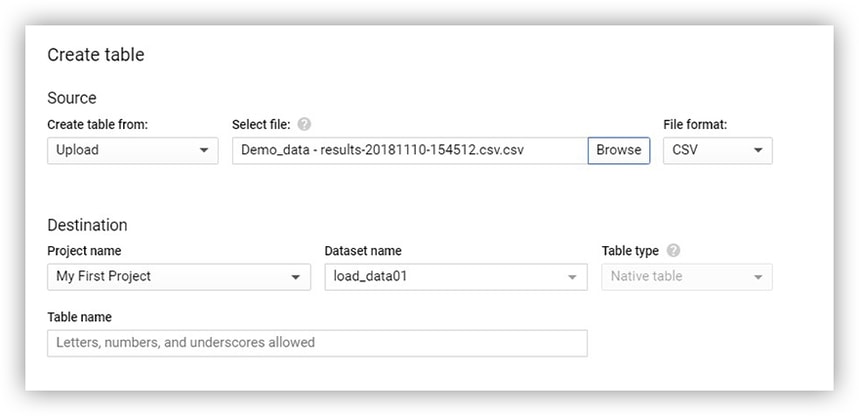
Specify the below details in the Create table panel.
In the Source section, select the Google Cloud Storage in the Create table from the list and then follow the below steps.
- You can either select the file from the Cloud Storage bucket or enter the Cloud Storage URI. Multiple URLs cannot be added to the Cloud console, but you can also include wildcards. The Cloud Storage bucket must be in the same location as the dataset, which contains the table you want to create, append or overwrite.
- Select csv for the file format.
Specify the following details in the Destination section.
- Select a dataset in which you want to create the table.
- Enter the name of the table which you want to create in the Table field.
- Verify the Table field is set to Native table.
In the Schema section, you can enter the Schema definition. Select Auto-detect to enable the auto-detection of the Schema. Enter the Schema information using any of the following ways.
- Click on Edit as Text and paste the Schema in the form of JSON arrays. While using JSON arrays, you can generate the Schema using the same process as creating a JSON schema file. Use the below command for viewing the Schema of the existing table in JSON format.
bq show --format=prettyjson dataset.table- Click on the Add field and enter the table schema. Enter each field’s name, type, and mode.
Click on the Advanced Options and follow the next instructions for creating a table in BigQuery.
Why Choose Hevo’s No-Code Data Pipeline to Connect Front to BigQuery?
Exporting Front data and importing it to Google BigQuery manually seems straightforward, but this process does not allow users to work with real-time data. Therefore, users can use standard APIs as an alternative to connect Front to BigQuery.
But, you need to have a strong technical team to use APIs. As a result, to overcome all such issues, you can use third-party ETL tools such as Hevo data that can allow seamless and autonomous integration from Front to BigQuery.
Conclusion
In this article, you learned to connect Front to BigQuery. Front aims at strengthening customer relationships for organizations by acquiring customer data from several channels in one place. Although Front provides analytics, to obtain in-depth analysis, you can store the data in a centralized repository like Google BigQuery, which can be further used with BI tools to make informed decisions.
Hevo Data offers a No-code Data Pipeline that can automate your data transfer process, hence allowing you to focus on other aspects of your business like Analytics, Marketing, Customer Management, etc.
This platform allows you to transfer data from 150+ sources (including 40+ Free Sources) such as Front and cloud-based Data Warehouses like Google BigQuery. It will provide you with a hassle-free experience and make your work life much easier.
Frequently Asked Questions
1. What is BigQuery equivalent to?
BigQuery is often considered equivalent to a cloud data warehouse or big data analytics platform.
2. Is BigQuery a SQL or Nosql?
BigQuery is a SQL-based data warehouse.
3. Why is BigQuery so popular?
BigQuery is popular due to its scalability, serverless architecture, high performance, cost efficiency, integration with Google Cloud services, support for machine learning, and real-time data ingestion capabilities.





